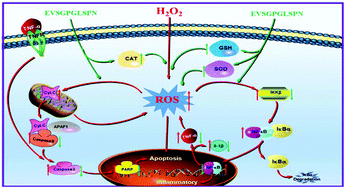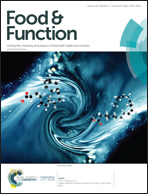Potential mechanisms mediating the protective effects of a peptide from walnut (Juglans mandshurica Maxim.) against hydrogen peroxide induced neurotoxicity in PC12 cells
Abstract
Amelioration of oxidative stress has been the main approach to improve neurodegenerative disorders. In the present study, a walnut peptide with a strong capacity of scavenging reactive oxygen species (ROS) was purified and identified as EVSGPGLSPN by SEC, RP-HPLC, and HPLC-MS/MS. Treatment with EVSGPGLSPN could significantly (P < 0.05) reduce ROS generation, and increase cell viability, and superoxide dismutase (SOD), catalase (CAT), and glutathione peroxidase (GSH-px) activities in a dose-dependent manner in hydrogen peroxide induced PC12 cells. Western blot and immunofluorescence analysis showed that EVSGPGLSPN suppressed the expression of IKKβ and p65 to inhibit NF-κB pathway activation, attenuating the neurotoxic cascade by overexpression of IL-1β and TNF-α. Moreover, EVSGPGLSPN inhibited apoptosis by suppressing the expression of cytochrome C, caspase-9, caspase-3, and PARP. Additionally, it also up-regulated the expression of p-CREB and synaptophysin in oxidatively damaged PC12 cells. Thus, EVSGPGLSPN may protect against hydrogen peroxide induced neurotoxicity by enhancing the activity of antioxidant enzymes and blocking the NF-κB/caspase pathways.



 Please wait while we load your content...
Please wait while we load your content...